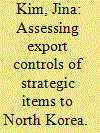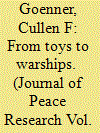| Srl | Item |
| 1 |
ID:
154928


|
|
|
|
|
| Summary/Abstract |
This paper aims to show trading patterns of certain items highly likely to be used
to develop nuclear and missile programs in North Korea. It analyzed North Korea’s
trade of nuclear―and missile―related items for ten years from 2006 to 2015 to
identify items in large volume as well as in increased demand and key suppliers
that contribute to sanctions―busting. This paper found that UN sanctions against
North Korea were not effective in controlling the flow of strategic items to North
Korea. Rather, a small number of states are responsible for a large share of trade
with North Korea that has continued to seek alternative suppliers. It also found
that China is a single supplier for multiple items and plays a major role along with
several others that either specialize in exports of specific items or gradually expand
the scope of supplies. Because the presence of a third country that provides North
Korea’s resilience and diversion of sanctions is crucial, this paper recommends
policy suggestions to enhance effectiveness of the existing sanctions regime.
|
|
|
|
|
|
|
|
|
|
|
|
|
|
|
|
| 2 |
ID:
100390


|
|
|
|
|
| Publication |
2010.
|
| Summary/Abstract |
The United States recently proposed to sell Saudi Arabia advanced weaponry worth 20 billion dollars over the next 10 years. The volume of trade, while significant, is second in the news headline that the United States would provide Saudi Arabia with precision-guided bombs, upgrades to its fighters, and new naval vessels. Trade of strategic commodities, such as armaments, suggests a strong interdependence between countries, which may influence international relations differently than the same volume of toys traded between nations. The author posits the volume and pattern of commodities that countries trade with each other are both relevant to interstate conflict. Commodities are heterogeneous and thus vary in terms of their strategic importance, substitutability, and ease of expropriation. This heterogeneity, along with the volume of trade, influences the opportunity cost of lost trade caused by conflict. This article empirically examines whether the pattern of trade is relevant to conflict for the period 1962-2000. The results from both single and simultaneous equations models indicate that increasing the share of bilateral trade in energy, non-ferrous metals, and electronics increases conflict, whereas for chemicals and arms it reduces conflict. Differences in these strategic commodities' elasticity of import demand and export supply, along with their ease of expropriation, contribute to the heterogeneous effects.
|
|
|
|
|
|
|
|
|
|
|
|
|
|
|
|
| 3 |
ID:
179961


|
|
|
|
|
| Summary/Abstract |
The usage of foreign direct investment (FDI) is a crucial element in the economic growth literature focusing on sustainable development. In the case of the aerospace sector, security considerations restrict FDI flows and the market-based creation of multi-national enterprises (MNEs), even more than they restrict trade. The role of the government is instrumental as such industries as they exercise significant control over structure and performance through procurement and regulatory aspects. Moreover, there are countries like the US whose aerospace is a leading exporting sector, while significant government expenditure flows impact through fiscal policy the economy at large. The analysis in this paper applies a sectoral analysis of economic development based on the ownership-location-internalization (OLI) theoretic framework for MNE activity for the case of the aerospace industry combined with the strategic trade and macroeconomic implications. The behavior of the government is examined within the macroeconomic, strategic economic and security framework towardidentifying a comprehensive framework of analysis.
|
|
|
|
|
|
|
|
|
|
|
|
|
|
|
|
| 4 |
ID:
143558


|
|
|
|
|
| Summary/Abstract |
One of the most important arguments with which China has sought to develop amicable relations with its neighbours has been the promise of economic benefits. Yet, this paper argues, these gains have remained limited. In spite of limited available data, the paper shows that China’s contribution to the rest of Asia’s GDP has been small and for most neighbours negative. Moreover, China is increasingly impelling those countries into partnerships that look unequal rather than equal. While Beijing has tried to mitigate frustration by promising to rebalance its economy and to create more export opportunities, the paper goes on to reveal that China is in fact readying itself to make another major push for exports itself and to pursue its own open-door policy.
|
|
|
|
|
|
|
|
|
|
|
|
|
|
|
|